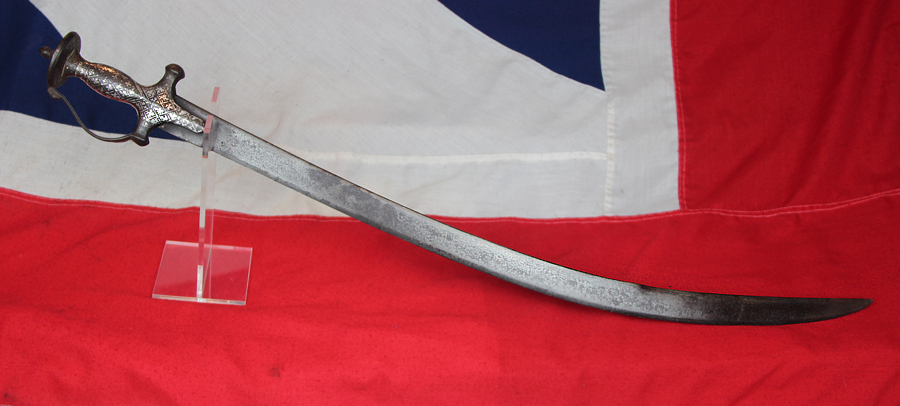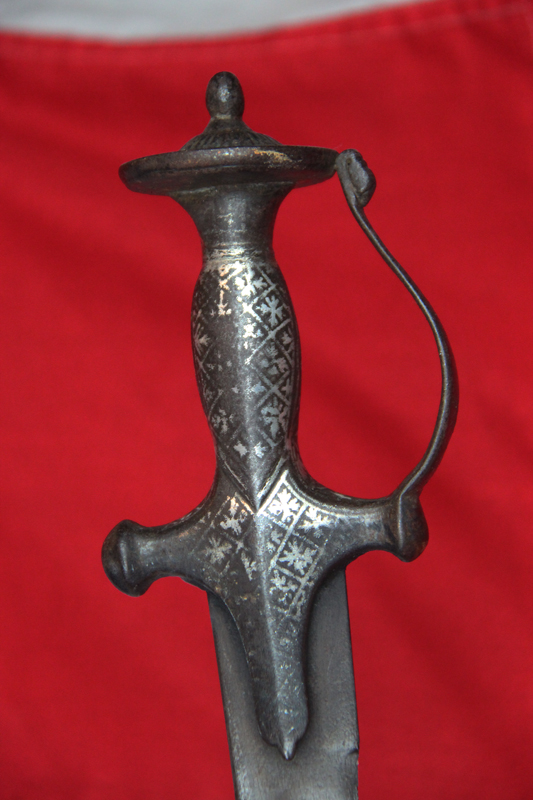Superb Antique Indian Tulwar 17th to 18th Century Silver Decor Hilted Sword With Hybrid Wootz Damascus Shamshir Blade. It Has Just Returned From Expert Museum Grade Conservation, Polishing & Etching of The Blade To Reveal Its Stunning Pattern
A superb period sword, with a very good superb hybrid wootz Damascus shamshir steel blade. Hybrid Damascus wootz has a more open wood type running grain with larger patterns than plain wootz that has often small tight curls.
Silver decorated iron Lahore hilt decorated with stunning design with matching lined cap pommel. Strong and powerful blade of substance. There are clear indications that this particular hilt is of Punjab manufacture: the fat vase shape of the grip section, the slightly forward angle of the quillons and the beautiful silver koftgari.
For those familiar with fine Japanese blades, we notice just how incredibly similar hybrid Wootz can appear by comparison to the hamon and hada of some early Japanese tamahagane steel blades. In fact, the similarity is quite remarkable.
A sword as popular within the Sikh Empire as the Mughal Empire.
The hilt also known as tulwar comprises langets with lotus-head outlines, domed quillons, and a centrally swollen grip. A knuckle guard with a terminal that recurves toward the disc-pommel which has been attached with a pointed sunburst plaque, a decorative feature further fitted at its centre with a dome and lotus bud finial.
Persian: شمشیر (type, which refers to a Persian or Iranian sword with a radical curve. The name is derived from the shamshīr, which means “lion’s claw or lions tale” in the Persian language – pointing towards the curve of the blade. These types of blades are normally used for slashing unarmored opponents either on foot or mounted; while the tip could be used for thrusting. In India, the term ‘Goliya’ (meaning circle) was used to describe these types of blades; referring to their curve.
The Tulwar had historically been the quintessential combat sword used by Sikhs as their sacred kirpan due to its superior handling while mounted on horseback. With a curved blade optimized for cutting and slashing with sweeping cuts delivered from the shoulder by a horseman the curved blade of the tulwar could strike repeated blows without the danger of the blade getting stuck in bone or armour. It allowed for fierce slashing on all sides cutting through enemy formations while mounted on horseback.
Emperor Aurangzeb was the last significant Mughal emperor of India. His reign lasted from 1658 to 1707. During this phase, the empire had reached its largest geographical expansion. Nevertheless it was during this time period that the first sign of decline of the great Moghul Empire was noticed. The reasons were many. The bureaucracy became corrupted and the army implemented outdated tactics and obsolete weaponry. The Moghul Empire was descended from Turko-Mongol, Rajputorigins. It reigned a significant part of the subcontinent of Asia from the initial part of the 16th century to the middle of the 19th century. When it was at the peak of its power, around the 18th century, it controlled a major part of the Asian subcontinent and portions of the current Afghanistan. To understand it's wealth and influence, in 1600 the Emperor Akbar had revenues from his empire of £17.5 million pounds per annum, and 200 years later, in 1800, the exchequer of the entire British Empire had revenues of just £16 million pounds. It has been asked, that, although he had the income per annum of around 500 billion pounds a year in today's value,but was he actually happy? Apparently,...yes, he was ecstatic.
31 inch blade measured across the curve. No scabbard
Code: 22647
2250.00 GBP






